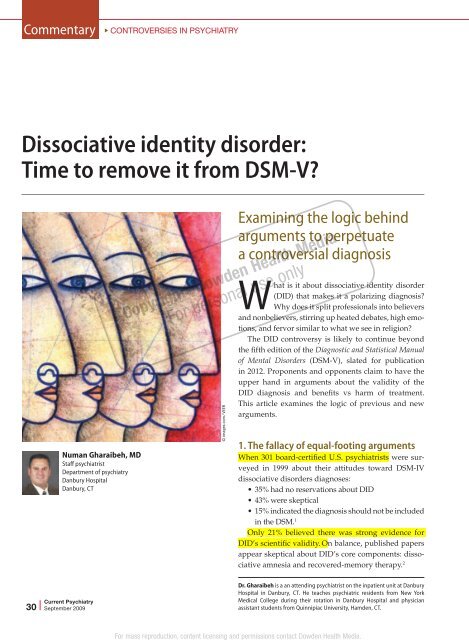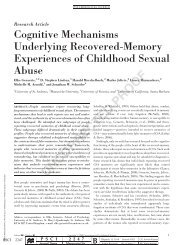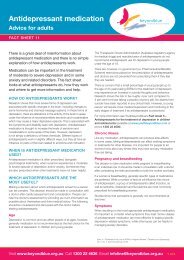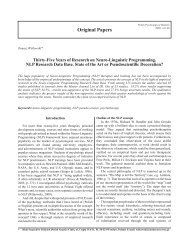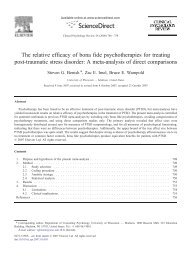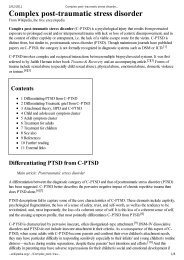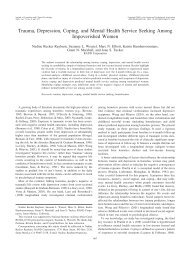Dissociative identity disorder: Time to remove it from DSM-V ...
Dissociative identity disorder: Time to remove it from DSM-V ...
Dissociative identity disorder: Time to remove it from DSM-V ...
Create successful ePaper yourself
Turn your PDF publications into a flip-book with our unique Google optimized e-Paper software.
For mass reproduction, content licensing and permissions contact Dowden Health Media.<br />
Commentary<br />
CONTROVERSIES IN PSYCHIATRY<br />
<strong>Dissociative</strong> <strong>ident<strong>it</strong>y</strong> <strong>disorder</strong>:<br />
<strong>Time</strong> <strong>to</strong> <strong>remove</strong> <strong>it</strong> <strong>from</strong> <strong>DSM</strong>-V?<br />
Numan Gharaibeh, MD<br />
Staff psychiatrist<br />
Department of psychiatry<br />
Danbury Hosp<strong>it</strong>al<br />
Danbury, CT<br />
Examining the logic behind<br />
arguments <strong>to</strong> perpetuate<br />
a controversial diagnosis<br />
What is <strong>it</strong> about dissociative <strong>ident<strong>it</strong>y</strong> <strong>disorder</strong><br />
(DID) that makes <strong>it</strong> a polarizing diagnosis?<br />
Why does <strong>it</strong> spl<strong>it</strong> professionals in<strong>to</strong> believers<br />
and nonbelievers, stirring up heated debates, high emotions,<br />
and fervor similar <strong>to</strong> what we see in religion?<br />
The DID controversy is likely <strong>to</strong> continue beyond<br />
the fifth ed<strong>it</strong>ion of the Diagnostic and Statistical Manual<br />
of Mental Disorders (<strong>DSM</strong>-V), slated for publication<br />
in 2012. Proponents and opponents claim <strong>to</strong> have the<br />
upper hand in arguments about the valid<strong>it</strong>y of the<br />
DID diagnosis and benef<strong>it</strong>s vs harm of treatment.<br />
This article examines the logic of previous and new<br />
arguments.<br />
Copyright ® Dowden Health Media<br />
For personal use only<br />
© images.com / VEER<br />
1. The fallacy of equal-footing arguments<br />
When 301 board-certified U.S. psychiatrists were surveyed<br />
in 1999 about their att<strong>it</strong>udes <strong>to</strong>ward <strong>DSM</strong>-IV<br />
dissociative <strong>disorder</strong>s diagnoses:<br />
• 35% had no reservations about DID<br />
• 43% were skeptical<br />
• 15% indicated the diagnosis should not be included<br />
in the <strong>DSM</strong>. 1<br />
Only 21% believed there was strong evidence for<br />
DID’s scientific valid<strong>it</strong>y. On balance, published papers<br />
appear skeptical about DID’s core components: dissociative<br />
amnesia and recovered-memory therapy. 2<br />
30<br />
Current Psychiatry<br />
September 2009<br />
Dr. Gharaibeh is a an attending psychiatrist on the inpatient un<strong>it</strong> at Danbury<br />
Hosp<strong>it</strong>al in Danbury, CT. He teaches psychiatric residents <strong>from</strong> New York<br />
Medical College during their rotation in Danbury Hosp<strong>it</strong>al and physician<br />
assistant students <strong>from</strong> Quinnipiac Univers<strong>it</strong>y, Hamden, CT.
DID skeptics are sometimes accused of<br />
“denial” or “reluctance” <strong>to</strong> accept this diagnosis.<br />
Informed skepticism is acceptable—<br />
even encouraged—in making a diagnosis<br />
of malingering, fact<strong>it</strong>ious <strong>disorder</strong>, some<br />
personal<strong>it</strong>y <strong>disorder</strong>s, substance abuse, and<br />
psychotic states, <strong>to</strong> name a few. Why is informed<br />
skepticism about DID frowned on?<br />
In medical and surgical specialties, informed<br />
skepticism is encouraged so that the<br />
pract<strong>it</strong>ioner challenges his or her assumptions<br />
about a possible diagnosis through a<br />
methodical process of inclusion, exclusion,<br />
and hypothesis testing. I argue that l<strong>it</strong>tle or<br />
no skepticism is substandard practice, if not<br />
negligence.<br />
Bertrand Russell’s celestial teapot parable<br />
(Box 1) 3 exposed the fallacy of equal-footing<br />
arguments (ie, in any debate or argument<br />
that has 2 sides, the 2 sides are not necessarily<br />
on equal footing). Russell’s argument is<br />
valid for any belief system relying on fa<strong>it</strong>h.<br />
Now that DID is in the “ancient book”<br />
(<strong>DSM</strong>-IV), the burden of proof by some<br />
magical logic has shifted <strong>to</strong> “nonbelievers.”<br />
In law that is called precedent, but law is<br />
even less scientific than psychiatry and not<br />
the best example <strong>to</strong> follow. A mistake made<br />
100 years ago is still a mistake.<br />
Box 1<br />
Bertrand Russell’s ‘celestial<br />
teapot’ analogy on religion<br />
In 1952, Br<strong>it</strong>ish philosopher Bertrand<br />
Russell used the analogy of a teapot in<br />
space <strong>to</strong> illustrate the difficulty skeptics<br />
face when questioning unfalsifiable claims.<br />
Russell’s argument involved religious belief,<br />
but <strong>it</strong> is valid for other belief systems relying<br />
on fa<strong>it</strong>h. Here is the celestial teapot analogy:<br />
“If I were <strong>to</strong> suggest that between Earth and<br />
Mars there is a china teapot revolving about<br />
the Sun in an elliptical orb<strong>it</strong>, nobody would<br />
be able <strong>to</strong> disprove my assertion provided<br />
I were careful <strong>to</strong> add that the teapot is<br />
<strong>to</strong>o small <strong>to</strong> be revealed even by our most<br />
powerful telescopes. But if I were <strong>to</strong> go<br />
on <strong>to</strong> say that, since my assertion cannot<br />
be disproved, <strong>it</strong> is in<strong>to</strong>lerable presumption<br />
on the part of human reason <strong>to</strong> doubt <strong>it</strong>,<br />
I should rightly be thought <strong>to</strong> be talking<br />
nonsense. If, however, the existence of such<br />
a teapot were affirmed in ancient books,<br />
taught as the sacred truth every Sunday,<br />
and instilled in<strong>to</strong> the minds of children at<br />
school, hes<strong>it</strong>ation <strong>to</strong> believe in <strong>it</strong>s existence<br />
would be a mark of eccentric<strong>it</strong>y and<br />
ent<strong>it</strong>le the doubter <strong>to</strong> the attention of the<br />
psychiatrist in an enlightened age or of the<br />
Inquisi<strong>to</strong>r in an earlier time.”<br />
Source: Reference 3<br />
Clinical Point<br />
An extensive review<br />
found no proof that<br />
DID results <strong>from</strong><br />
childhood trauma<br />
or that DID cases in<br />
children are almost<br />
never reported<br />
2. Illogic of causation<br />
Piper and Merskey’s extensive l<strong>it</strong>erature review<br />
4,5 examined the presumed association<br />
between DID and child hood abuse (mostly<br />
sexual). They found:<br />
• no proof that DID results <strong>from</strong> childhood<br />
trauma or that DID cases in children<br />
are almost never reported<br />
• “consistent evidence of blatant iatrogenesis”<br />
in the practice of some DID<br />
proponents.<br />
One can easily turn the logic around<br />
by claiming that a DID diagnosis causes<br />
memories of childhood sexual abuse.<br />
As for patients’ presumed reluctance<br />
<strong>to</strong> report childhood abuse, I w<strong>it</strong>nessed in<br />
every one of my 15 alleged cases of DID<br />
(all female) not reluctance but a strong<br />
tendency <strong>to</strong> flaunt their diagnosis and<br />
symp<strong>to</strong>ms and an eagerness <strong>to</strong> re-tell their<br />
s<strong>to</strong>ries w<strong>it</strong>h graphic detail, usually unprovoked.<br />
Patients w<strong>it</strong>h a DID diagnosis seem<br />
<strong>to</strong> have a “powerful vested interest”—<strong>to</strong><br />
borrow Paul McHugh’s expression 6 —in<br />
sustaining the DID diagnosis, symp<strong>to</strong>ms,<br />
behaviors, and therapy as an end in <strong>it</strong>self.<br />
DID proponents acknowledge that iatrogenic<br />
artifacts may exist in the diagnosis<br />
and treatment. However, they almost immediately<br />
insinuate that DID patients’<br />
“subtle defensive strategies” generate these<br />
artifacts. Greaves’ discussion of multiple<br />
personal<strong>it</strong>y <strong>disorder</strong> 7 acknowledged that<br />
overdiagnosis may be driven by therapists’<br />
desire <strong>to</strong> “attain narcissistic gratification at<br />
‘having a multiple [sic] of their own’” but<br />
blamed this on “neophytes.”<br />
3. Tau<strong>to</strong>logy in DID’s defin<strong>it</strong>ion<br />
<strong>DSM</strong>-IV’s cr<strong>it</strong>erion A for DID is in fact a<br />
defin<strong>it</strong>ion: “the presence of 2 or more distinct<br />
ident<strong>it</strong>ies or personal<strong>it</strong>y states (each<br />
w<strong>it</strong>h <strong>it</strong>s own relatively enduring pattern of<br />
ONLINE<br />
ONLY<br />
Discuss this article at<br />
http://CurrentPsychiatry.<br />
blogspot.com<br />
Current Psychiatry<br />
Vol. 8, No. 9 31
<strong>Dissociative</strong><br />
<strong>ident<strong>it</strong>y</strong><br />
<strong>disorder</strong><br />
Clinical Point<br />
<strong>DSM</strong>-IV cr<strong>it</strong>eria A<br />
and B for dissociative<br />
<strong>ident<strong>it</strong>y</strong> <strong>disorder</strong><br />
show circular<strong>it</strong>y<br />
and redundancy; if<br />
cr<strong>it</strong>erion A is met,<br />
then B must be met<br />
Table<br />
A meaningless word?<br />
‘Dissociation’ is used<br />
<strong>to</strong> describe many things<br />
Daydreaming or fantasizing<br />
Memory lapses caused by benzodiazepines<br />
Preoccupation w<strong>it</strong>h everyday worries<br />
Preoccupation w<strong>it</strong>h internal stimuli (such as<br />
audi<strong>to</strong>ry hallucinations or delusional thoughts)<br />
Poor attentiveness<br />
Histrionic/theatrical behavior <strong>to</strong> avoid upsetting<br />
the patient or <strong>to</strong> provide a face-saving<br />
explanation<br />
Daydreaming while driving (‘highway<br />
dissociation’ or ‘highway hypnosis’)<br />
Getting engrossed/captivated by a novel, a<br />
movie, or a piece of radio journalism or music<br />
perceiving, relating <strong>to</strong>, and thinking about<br />
the environment and self).” 8 Together,<br />
cr<strong>it</strong>eria A and B show circular<strong>it</strong>y and redundancy.<br />
If A is met, then B must be met<br />
because “a person’s behavior” is part of<br />
her or his <strong>ident<strong>it</strong>y</strong> and personal<strong>it</strong>y state,<br />
which was established in A.<br />
Tau<strong>to</strong>logy is a major shortcoming of the<br />
descriptive system for psychopathology in<br />
general. Of greater clinical value are observing<br />
a patient’s actions, listening <strong>to</strong> his<br />
or her words, learning his or her his<strong>to</strong>ry,<br />
studying his or her expressions, and noting<br />
his or her relationships. 9<br />
the concept that these terms try <strong>to</strong> communicate<br />
make speaking a common language<br />
extremely difficult. To borrow <strong>from</strong><br />
W<strong>it</strong>tgenstein, psychiatrists’ intellect is bew<strong>it</strong>ched<br />
by language. 11<br />
Words fail <strong>to</strong> communicate experiences<br />
such as the taste of red wine or the feeling<br />
of sand beneath bare feet. It is almost futile<br />
<strong>to</strong> try <strong>to</strong> define dissociation, <strong>ident<strong>it</strong>y</strong>, personal<strong>it</strong>y<br />
states, etc., using words or even<br />
pictures. More defin<strong>it</strong>ions and agreement<br />
on stricter defin<strong>it</strong>ions would not provide<br />
greater clar<strong>it</strong>y or solve the problem of firstperson<br />
author<strong>it</strong>y.<br />
An example is found in DID’s cr<strong>it</strong>erion<br />
B: “at least 2 of these ident<strong>it</strong>ies or personal<strong>it</strong>y<br />
states recurrently take control of the<br />
person’s behavior” [<strong>it</strong>alics mine]. “Possession”<br />
seems <strong>to</strong> be a f<strong>it</strong>ting word! Whether<br />
<strong>it</strong> is an alter or the devil taking control is a<br />
technical<strong>it</strong>y. Even more acceptable would<br />
be possessed by inconsolable anger, possessed<br />
by fierce jealousy, possessed by<br />
lust, possessed by hatred and vengeance,<br />
possessed by and obsessed w<strong>it</strong>h love, possessed<br />
by cocaine, etc.<br />
Dissociation is used <strong>to</strong> describe so many<br />
things that <strong>it</strong> has become almost meaningless<br />
(Table). I refer not only <strong>to</strong> defin<strong>it</strong>ional<br />
imprecision but also <strong>to</strong> a lack of consensus<br />
on the nature of the concept <strong>it</strong>self.<br />
The word “control” is another term on<br />
whose meaning almost no 2 psychiatrists<br />
agree. Consensus on defin<strong>it</strong>ions is elusive<br />
when words become divorced <strong>from</strong> the<br />
concepts they were intended <strong>to</strong> describe.<br />
32<br />
Current Psychiatry<br />
September 2009<br />
4. Bew<strong>it</strong>chment by language<br />
Psychiatrists could spend hours over strong<br />
cups of coffee arguing the meanings of terms<br />
such as “dissociation,” “presence,” “<strong>ident<strong>it</strong>y</strong>,”<br />
“personal<strong>it</strong>y state,” etc. Psychiatry has<br />
been targeted unfairly regarding where <strong>it</strong><br />
falls on the subjectiv<strong>it</strong>y-objectiv<strong>it</strong>y axis, but<br />
<strong>it</strong> has not fared that differently <strong>from</strong> other<br />
medical specialties. 10 Psychiatry, however,<br />
depends much more on language.<br />
Consider slippery terms such as personal<strong>it</strong>y,<br />
<strong>ident<strong>it</strong>y</strong>, self, dissociation, integration,<br />
alters, ego, ego states, trance states, personal<strong>it</strong>y<br />
states, unconscious, etc. Lack of precision,<br />
variabil<strong>it</strong>y in use of words and their<br />
meaning, and variabil<strong>it</strong>y in understanding<br />
5. Valid<strong>it</strong>y of first-person author<strong>it</strong>y<br />
The skeptic’s attempt <strong>to</strong> investigate a subjective<br />
phenomena—especially DID—is bound<br />
<strong>to</strong> break on the rocks of the first- person<br />
author<strong>it</strong>y, <strong>to</strong> borrow Donald Davidson’s<br />
words. 9 To support reliabil<strong>it</strong>y and valid<strong>it</strong>y<br />
of the diagnosis, dissociation researchers<br />
rely on “scales” and “instruments” <strong>to</strong> give<br />
the impression of objectiv<strong>it</strong>y, empiricism,<br />
and “science” hard at work. However, a<br />
quick look at some of the questions on these<br />
“instruments” reveals their assault on reason<br />
and intellect (Box 2, page 35). 12<br />
Proponents who claim DID is “sufficiently<br />
validated for inclusion in the current<br />
continued on page 35
continued <strong>from</strong> page 32<br />
and future versions of <strong>DSM</strong>” are <strong>to</strong> be commended<br />
for adding “much more research is<br />
needed in several areas.” 13 Piper and Merskey’s<br />
review 4,5 concluded that DID could<br />
not be reliably diagnosed.<br />
6. Does a DID diagnosis do harm?<br />
Webster’s 14 defines iatrogenic as: “Resulting<br />
<strong>from</strong> the activ<strong>it</strong>y of a physician. Originally<br />
applied <strong>to</strong> a <strong>disorder</strong> or <strong>disorder</strong>s inadvertently<br />
induced in the patient by the manner<br />
of the physician’s examination, discussion,<br />
or treatment, <strong>it</strong> now applies <strong>to</strong> any cond<strong>it</strong>ion<br />
occurring in a patient as result of medical<br />
treatment, such as a drug reaction.”<br />
A DID diagnosis has been blamed for<br />
misdiagnosis of other ent<strong>it</strong>ies, 15 patient<br />
mismanagement, 16 and inadequate treatment<br />
of depression. 17 Even when DID is<br />
treated w<strong>it</strong>h the best of intentions, undesired<br />
negative effects may result <strong>from</strong> psychotherapy,<br />
and some patients experience<br />
worsening of symp<strong>to</strong>ms and/or deterioration<br />
of functioning. 18,19<br />
In Creating Hysteria, Acocella 20 c<strong>it</strong>es examples<br />
of harm done <strong>to</strong> [alleged DID] patients<br />
and their families, including 2 high-profile<br />
cases under the care of a member of the<br />
<strong>DSM</strong>-IV work group on dissociation.<br />
7. How is self-deception possible?<br />
The abil<strong>it</strong>y <strong>to</strong> self-deceive has advantages<br />
and disadvantages, 21 and widespread deception<br />
is possible. Richard Dawkins’s The<br />
God Delusion, 22 Chris<strong>to</strong>pher H<strong>it</strong>chens’s God<br />
is Not Great, 23 and Michael Shermer’s Why<br />
People Believe Weird Things 24 are recent exposés<br />
of how self-deception and deception<br />
by charismatic figures occurs desp<strong>it</strong>e the<br />
progress “reason” has made.<br />
As w<strong>it</strong>h other belief systems that become<br />
entrenched in the face of cr<strong>it</strong>icism,<br />
DID proponents accuse cr<strong>it</strong>ics of denial, reluctance,<br />
and adopting “defense[s] against<br />
dealing w<strong>it</strong>h the real<strong>it</strong>y of child abuse in<br />
North America.” 20 One wonders why just<br />
North America! Why not Africa, w<strong>it</strong>h <strong>it</strong>s<br />
children in Sudan, Somalia, Zimbabwe—<br />
<strong>to</strong> name a few—enduring enough abuse<br />
<strong>to</strong> spread around the world several times<br />
over?<br />
Box 2<br />
Sample statements <strong>from</strong><br />
the Adolescent <strong>Dissociative</strong><br />
Experience Scale (A-DES)*<br />
A-DES: I get so wrapped up in watching TV,<br />
reading, or playing a video game that I don’t<br />
have any idea what’s going on around me.<br />
Comment: Although this <strong>it</strong>em seems like a<br />
joke, <strong>it</strong> is not meant as one. It is meant <strong>to</strong> be<br />
part of the serious business of science. Isn’t<br />
that what any ‘normal’ human would do if he or<br />
she has enough attention and concentration?<br />
A-DES: People tell me I do or say things<br />
that I don’t remember doing or saying.<br />
I get confused about whether I have done<br />
something or only thought about doing <strong>it</strong>.<br />
I can’t figure out if things really happened<br />
or if I only dreamed or thought about them.<br />
People tell me that I sometimes act so<br />
differently that I seem like a different person.<br />
Comment: These <strong>it</strong>ems are crafted in a way<br />
<strong>to</strong> encourage false pos<strong>it</strong>ives. First, ‘people<br />
tell me’ does not qualify as an ‘experience.’<br />
Second, one wonders why the scale was<br />
made up of declarative statements instead<br />
of questions. Third, ‘I seem like a different<br />
person’ is a leading statement.<br />
A-DES: I am so good at lying and acting<br />
that I believe <strong>it</strong> myself.<br />
Comment: This should be an immediate<br />
tip-off that the reporter is unreliable.<br />
A-DES: I feel like my past is a puzzle and<br />
some of the pieces are missing.<br />
Comment: Isn’t this the human cond<strong>it</strong>ion?<br />
*A-DES statements are <strong>it</strong>alicized; comments by Dr. Gharaibeh<br />
are in plain text<br />
Source: Reference 12<br />
Proponents also allege that part of the<br />
reason for “professionals’ reluctance” <strong>to</strong><br />
embrace DID is the “subtle presentation<br />
of the symp<strong>to</strong>ms.” 25 In other words, <strong>it</strong> is<br />
not reluctance; <strong>it</strong> is ignorance, w<strong>it</strong>h the<br />
insinuation that nonbelievers or skeptics<br />
are not smart enough <strong>to</strong> pick up on the<br />
subtle clinical presentation. I can’t see<br />
why professionals would be ignorant<br />
when <strong>it</strong> comes <strong>to</strong> dissociation as opposed<br />
<strong>to</strong> schizophrenia, depression, bipolar <strong>disorder</strong>,<br />
and almost all <strong>DSM</strong>-IV <strong>disorder</strong>s.<br />
Why this selective ignorance exists remains<br />
unexplained.<br />
continued<br />
Clinical Point<br />
Even when DID is<br />
treated w<strong>it</strong>h the<br />
best of intentions,<br />
undesired negative<br />
effects may result<br />
<strong>from</strong> psychotherapy<br />
Current Psychiatry<br />
Vol. 8, No. 9 35
<strong>Dissociative</strong><br />
<strong>ident<strong>it</strong>y</strong><br />
<strong>disorder</strong><br />
Clinical Point<br />
Strong adherents<br />
have a lot <strong>to</strong> gain<br />
<strong>from</strong> perpetuating<br />
DID; skeptics would<br />
gain nothing if DID<br />
were <strong>to</strong> disappear<br />
<strong>from</strong> <strong>DSM</strong> in 2012<br />
36<br />
Current Psychiatry<br />
September 2009<br />
8. Experts and conflict of interest<br />
<strong>DSM</strong>-V’s guidelines on conflict of interest<br />
are very welcome. One hopes conflict<br />
of interest does not refer only <strong>to</strong> financial<br />
relationships w<strong>it</strong>h pharmaceutical companies.<br />
Conflicts of interest can exert unseen<br />
influence, which—if made clear—would<br />
have a direct bearing of the reliabil<strong>it</strong>y and<br />
trustworthiness of the published l<strong>it</strong>erature.<br />
Strong adherents have a lot <strong>to</strong> gain <strong>from</strong><br />
perpetuating DID. Nonbelievers, skeptics,<br />
and opponents would gain nothing if DID<br />
disappeared <strong>from</strong> <strong>DSM</strong> <strong>to</strong>day or in 2012.<br />
The first potential conflict of interest<br />
for DID “experts” is financial gain. For example,<br />
a psychologist saw 1 of my patients<br />
(before I came <strong>to</strong> the scene) for 5 years for<br />
3 sessions a week (2 for adult alters and 1<br />
for childhood alters), w<strong>it</strong>h annual earnings<br />
of nearly $20,000. A self-declared expert<br />
would need only 10 patients <strong>to</strong> be better off<br />
than most psychiatrists.<br />
The second potential conflict of interest<br />
is personal gain in the form of narcissistic<br />
gratification, as mentioned above. Although<br />
DID proponents blame neophytes,<br />
“teachers” are no less prone <strong>to</strong> narcissistic<br />
gratification. Under this umbrella falls the<br />
DID experts’ interest in recogn<strong>it</strong>ion, fame,<br />
and easily acquired expertise. One may<br />
argue that self-arrogated expertise in this<br />
realm is much ado about nothing.<br />
The third potential conflict of interest is<br />
the very process of becoming an “expert.”<br />
The bias of this process is evident because<br />
if one does not accept a priori the presence<br />
of DID, he or she will never be adm<strong>it</strong>ted <strong>to</strong><br />
the exclusive club of “DID experts.” To attain<br />
the status of author<strong>it</strong>y or expert on this<br />
subject, one must be a believer. Otherwise,<br />
how would one claim <strong>to</strong> have diagnosed<br />
and treated hundreds of DID cases? It is a<br />
feedback loop that can’t be broken.<br />
References<br />
1. Pope HG Jr, Oliva PS, Hudson JI, et al. Att<strong>it</strong>udes <strong>to</strong>ward <strong>DSM</strong>-<br />
IV dissociative <strong>disorder</strong>s diagnoses among board-certified<br />
American psychiatrists. Am J Psychiatry. 1999;156(2):321-<br />
323.<br />
2. Pope HG Jr, Barry S, Bodkin A, et al. Tracking scientific<br />
interest in the dissociative <strong>disorder</strong>s: a study of scientific<br />
publication output 1984-2003. Psychother Psychosom.<br />
2006;75:19-24.<br />
3. Russell B. Is there a God? Available at: http://www.cfpf.<br />
org.uk/articles/religion/br/br_god.html. Accessed June 25,<br />
2009.<br />
Related Resources<br />
• Borch-Jacobsen M. Making minds and madness: <strong>from</strong><br />
hysteria <strong>to</strong> depression. New York, NY: Cambridge Univers<strong>it</strong>y<br />
Press; 2009.<br />
• Memory and real<strong>it</strong>y. False Memory Syndrome Foundation.<br />
www.fmsfonline.org.<br />
Disclosure<br />
Dr. Gharaibeh reports no financial relationship w<strong>it</strong>h any<br />
company whose products are mentioned in this article or<br />
w<strong>it</strong>h manufacturers of competing products.<br />
4. Piper A, Merskey H. The persistence of folly: a cr<strong>it</strong>ical<br />
examination of dissociative <strong>ident<strong>it</strong>y</strong> <strong>disorder</strong>. Part I. The<br />
excesses of an improbable concept. Can J Psychiatry.<br />
2004;49(9):592-600.<br />
5. Piper A, Merskey H. The persistence of folly: cr<strong>it</strong>ical<br />
examination of dissociative <strong>ident<strong>it</strong>y</strong> <strong>disorder</strong>. Part II. The<br />
defense and decline of multiple personal<strong>it</strong>y or dissociative<br />
<strong>ident<strong>it</strong>y</strong> <strong>disorder</strong>. Can J Psychiatry. 2004;49(10):678-683.<br />
6. McHugh PR. Multiple personal<strong>it</strong>y <strong>disorder</strong> (dissociative<br />
<strong>ident<strong>it</strong>y</strong> <strong>disorder</strong>). Available at: http://www.psycom.net/<br />
mchugh.html. Accessed August 5, 2009.<br />
7. Greaves GB. Observations on the claim of iatrogenesis of<br />
MPD: a discussion. Dissociation. 1989;2(2):99-104.<br />
8. Diagnostic and statistical manual of mental <strong>disorder</strong>s, 4th ed.<br />
Washing<strong>to</strong>n, DC: American Psychiatric Association; 1994.<br />
9. Davidson D. Subjective, intersubjective, objective. New York,<br />
NY: Oxford Univers<strong>it</strong>y Press; 2001:15.<br />
10. Pies R. Psychiatry clearly meets the ‘objectiv<strong>it</strong>y’ test.<br />
Psychiatric News. 2005;40(19):17.<br />
11. Sluga H, Stern DG. The Cambridge companion <strong>to</strong><br />
W<strong>it</strong>tgenstein. New York, NY: Cambridge Univers<strong>it</strong>y Press;<br />
1966.<br />
12. Armstrong JG, Putnam FW, Carlson EB, et al. Development<br />
and validation of a measure of adolescent dissociation: The<br />
Adolescent <strong>Dissociative</strong> Experience Scale. J Nerv Ment Dis.<br />
1997;185:491-497.<br />
13. Gleaves DH, May MC, Cardeña E. An examination of the<br />
diagnostic valid<strong>it</strong>y of dissociative <strong>ident<strong>it</strong>y</strong> <strong>disorder</strong>. Clin<br />
Psychol Rev. 2001;21(4):577-608.<br />
14. The new Webster’s international comprehensive dictionary of<br />
the English language. New York, NY: American International<br />
Press; 1991.<br />
15. Freeland A, Manchanda R, Chiu S, et al. Four cases of<br />
supposed multiple personal<strong>it</strong>y <strong>disorder</strong>: evidence of<br />
unjustified diagnoses. Can J Psychiatry. 1993;23:245-247.<br />
16. McHugh PR. Try <strong>to</strong> remember: psychiatry’s clash over<br />
meaning, memory, and mind. Washing<strong>to</strong>n, DC: Dana Press;<br />
2008.<br />
17. Fetkewicz J, Sharma V, Merskey H. A note on suicidal<br />
deterioration w<strong>it</strong>h recovered memory treatment. J Affect<br />
Disord. 2000;58:155-159.<br />
18. Hadley SW, Strupp HH. Contemporary views of negative<br />
effects in psychotherapy. An integrated account. Arch Gen<br />
Psychiatry. 1976;33(11):1291-1302.<br />
19. Bergin AE. The deterioration effect: a reply <strong>to</strong> Braucht. J<br />
Abnorm Psychol. 1970;75(3):300-302.<br />
20. Acocella J. Creating hysteria: women and multiple personal<strong>it</strong>y<br />
<strong>disorder</strong>. San Francisco, CA: Jossey-Bass Publishers; 1999:81.<br />
21. Nasrallah HA. Self-deception: a double-edged tra<strong>it</strong>. Current<br />
Psychiatry. 2008;7(7):14-16.<br />
22. Dawkins R. The God delusion. Bos<strong>to</strong>n, MA: Hough<strong>to</strong>n<br />
Mifflin; 2006.<br />
23. H<strong>it</strong>chens C. God is not great: how religion poisons<br />
everything. New York, NY: Twelve/Hachette Book Group;<br />
2007.<br />
24. Shermer M. Why people believe weird things: pseudoscience,<br />
superst<strong>it</strong>ion, and other confusions of our time. New York,<br />
NY: W.H. Freeman and Company; 1997.<br />
25. Coons PM. Child abuse and multiple personal<strong>it</strong>y <strong>disorder</strong>:<br />
review of the l<strong>it</strong>erature and suggestions for treatment. Child<br />
Abuse Negl. 1986;10(4):455-462.


